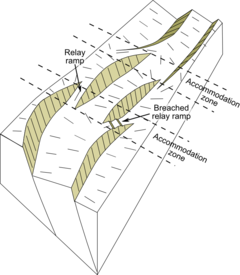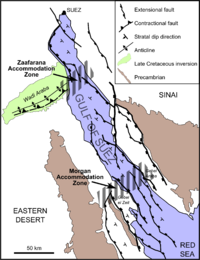
Back Grabenbruch ALS خسف (جيولوجيا) Arabic Rift AST Rift Azerbaijani Рыфт Byelorussian Рифт Bulgarian रिफ्ट Bihari Rift Catalan Rift Czech Grabenbruch German


In geology, a rift is a linear zone where the lithosphere is being pulled apart[1][2] and is an example of extensional tectonics.[3] Typical rift features are a central linear downfaulted depression, called a graben, or more commonly a half-graben with normal faulting and rift-flank uplifts mainly on one side.[4] Where rifts remain above sea level they form a rift valley, which may be filled by water forming a rift lake. The axis of the rift area may contain volcanic rocks, and active volcanism is a part of many, but not all, active rift systems.
Major rifts occur along the central axis of most mid-ocean ridges, where new oceanic crust and lithosphere is created along a divergent boundary between two tectonic plates.
Failed rifts are the result of continental rifting that failed to continue to the point of break-up. Typically the transition from rifting to spreading develops at a triple junction where three converging rifts meet over a hotspot. Two of these evolve to the point of seafloor spreading, while the third ultimately fails, becoming an aulacogen.
- ^ Rift valley: definition and geologic significance, Giacomo Corti, The Ethiopian Rift Valley
- ^ Decompressional Melting During Extension of Continental Lithosphere, Jolante van Wijk, MantlePlumes.org
- ^ Plate Tectonics: Lecture 2, Geology Department at University of Leicester
- ^ Leeder, M.R.; Gawthorpe, R.L. (1987). "Sedimentary models for extensional tilt-block/half-graben basins" (PDF). In Coward, M.P.; Dewey, J.F.; Hancock, P.L. (eds.). Continental Extensional Tectonics. Geological Society, Special Publications. Vol. 28. pp. 139–152. ISBN 9780632016051.
© MMXXIII Rich X Search. We shall prevail. All rights reserved. Rich X Search